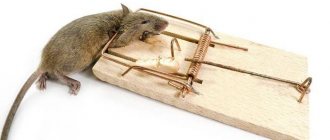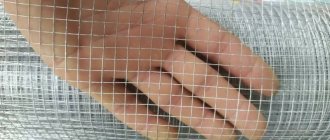02/26/201702/26/2017 Maria Ivanova 2 comments
A peculiar stereotype is the opinion that the appearance of rats is possible only in one’s own home, but not in apartments. However, the urban environment has many attractions for rats. Basements, attics, cluttered hallways, and garbage chutes become excellent homes for them. Accordingly, residents of the first floors suffer from rodent infestations more often than other apartment residents.
The appearance of a rat in an apartment is the last thing any sane person dreams of. And it’s not just that these rodents damage supplies, can damage wiring by cutting wires, and harm pets.
The danger is that rodents are carriers of various dangerous infectious diseases. Neighborhood with such a dangerous guest is unlikely to please anyone.
It is known that within a month a rat is capable of breeding about 20 offspring. This means that you should not hesitate to exterminate the rodent and find out ways to catch the rat.
Before you start exterminating your new neighbor, it’s worth finding out how the animal got into the apartment and sealing the passage. Rats are very cunning and voracious animals. They use any loopholes to get into the house and solve the problem of food.
- 1 Useful tips for rodent control
- 2 Folk remedies for getting rid of rodents
- 3 Ways to exterminate rats in an apartment
- 4 Lethal rodent traps
- 5 Security measures
Precautions before fishing
Rodents spoil food and things and are aggressive towards humans. Their bites or contacts can cause up to 20 types of deadly infectious diseases (Rat bite - why it is dangerous and what to do after the bite, read more in the article here). For safety reasons, before catching it is important:
- Wear construction leather gloves, which will serve as protection against bites.
- Place traps away from children and pets.
- Act quickly and calmly when encountering a live rodent. You can spray your face with deodorant or pesticide.
- Do not touch a live or dead animal without personal protective equipment.
- In case of a bite or scratch, quickly rinse all contact areas on the body with water. If necessary, go to the first aid station.
- Bury the animal in a place inaccessible to other animals.
- When baiting poultry and livestock in outbuildings, do not use toxic chemicals. Prefer mechanical methods of catching: traps, glue, ultrasound.
Reference! Rodents cannot stand the smell of burning. They run away from him. It is effective to carry out fumigation with smoke bombs for baiting. But they pose a potential danger to pets. Curious geese, chickens, and cats can accidentally eat poison and become poisoned. It is important to temporarily isolate pets to prevent contact, move them to another place of residence, or fumigate the premises while they are out on the pasture. During the period of deratization, you can set up a pen on the street, covering it with a chain-link mesh.
Read more about how and why rats attack people in the article here.
About electric traps for rats and mice and the advisability of their use at home
The principle of operation of an electric rat trap is that a rat climbs into it, attracted by the smell of the bait, and when it touches a metal electrode, an electrical circuit is closed on the animal - an electric shock occurs. The video below shows an example of how such a device works:
Electric rat traps are highly effective and easy to use, but they have a serious drawback - on average, such devices are much more expensive than a standard rat trap-squeeze (and some models cost tens of times more).
In general, such a device is well suited for those who want to kill all rodents in the room without blood and without the use of poison. Read more about electric rat traps in a separate article: Using electric rat traps to control rodents
How to find a rodent
Rats are inhabitants of basements, garbage chutes, attics, barns, cottages, outbuildings, landfills, storage rooms, garages, and supply cellars. Traps are placed near their expected places of residence.
Rodents often dig holes in garden plots. It is not difficult to identify them in the event of the appearance of passages released after laying with grass and paper. Rats are cunning. Unlikely to appear in illuminated areas. They prefer to bypass them, moving along the walls.
Advice! If you set traps, be sure to go against the direction of movement of the animals. It is important to add bait periodically. If not the second time, then the third time the rat will definitely get caught.
You can find a rodent in a chicken coop (3 best ways to get rid of rats in a chicken coop) or barn by its appearance there:
- droppings in the form of oval brown granules;
- rat paw print;
- teeth marks on food and objects;
- anxiety of animals, birds;
- broken eggs, shells on the floor.
Rats usually breed there and try to live in food storage areas. In winter, in search of food, they can sneak into high-rise apartments through ventilation grilles, cracks in the floors, and sewer pipes. A small hole is enough for rodents to enter. The fact that animals actually live in a residential area will be indicated by:
- excrement (round pellets);
- rustling at night;
- chewed food bags, holes in the floor;
- specific unpleasant odor in the room.
Reference! Rodents love to be in places where there is a lot of trash, old things and people rarely appear. For example, in country houses, garages. Rats are gluttonous. They can use any smallest opening for food.
How rats get into houses and why rodents are dangerous to humans
Rats are one of the most obvious signs of unsanitary conditions; they live where there is something to eat. Among the conditions that are favorable for the life of pests are the presence of food waste (crumbs, peelings, bones, cereals), protection from cold, and high humidity. Rats can also infest houses in the vicinity of their source. It is not uncommon for these animals to appear in multi-storey buildings where there is a garbage chute, along the walls of which rats successfully travel long distances, entering apartments through open doors or ventilation holes. The first floors are most susceptible to rat invasion, where rodents flee from basements and cellars located in the basement. The private sector suffers the most from these pests. Parasitic mammals love pigsties, chicken coops and other places where food debris is poorly removed.
I first saw a rat in the backyard after a neighbor decided to raise piglets without having the habit of keeping the animals clean. A few months later, a family of rodents was discovered and quickly eliminated in a woodshed located on my property.
The main threat that rats pose to humans is the diseases they transmit. You can become infected not only through a bite, but also through feces, which contain bacteria that are dangerous to human life. The most common diseases transmitted by rodents are:
- leptospirosis;
- rabies;
- tularemia;
- typhus, etc.
How to catch without a rat trap
It is not at all necessary to buy dangerous poisons or expensive industrial rat traps. Effective homemade traps will help you quickly and inexpensively catch a rat in a warehouse, barn, garage, office, apartment, or private house:
- Smooth tall plastic bucket. Place tasty bait on the bottom. The rat will be drawn to the pleasant aroma and fall to the bottom without the opportunity to get back out. You can fill a bucket 1/3 with water and place it near the table. Place a piece of plywood or plastic on the table and a bait on the end. The rat will follow the smell and fall into a bucket of water under its own weight.
- Glue. Grease the hard base of the cardboard. Place the bait in the center. This method will allow you to catch several young rats at once.
- Flour and gypsum. Prepare a 1/1 mixture and place a container of water nearby. Rodents will be attracted by the smell of flour, and drinking ordinary water will lead to death.
- A wooden block will help catch rats without a rat trap. Cut a tunnel in the block. Attach a spring with a wire loop above it. Place it in bait close to the entrance to the tunnel. Drill 2 holes at the top and bottom of the tunnel, stretch the thread in the middle. Tie it over the spring, pressing it against the block so that the loop coincides with the passage in the tunnel. The rat will stumble upon the thread in search of food and begin to chew it. The spring will unclench and tighten the noose on the animal’s body, followed by suffocation.
By the way! The best trap is a rat-catcher, the smell of which rodents cannot stand and is unlikely to appear in the house. If there is no cat, then it is recommended to start baiting with homemade mechanical devices in which you put tasty food supplies.
Lethal rodent traps
- To kill rats, you can make a mixture of flour and alabaster in a 1:1 ratio. The composition must be laid out next to the holes and containers with water placed nearby. Having eaten the product and washed it down with water, the rodent is doomed to death, since the water will dissolve the gypsum that has entered the rodent’s body. It is important to understand that this method is not the most humane and will doom the animal to a painful death.
- Don't forget about spring mousetraps. Moreover, they have been replaced by new generation spring traps. Unlike mice, rats have a larger body weight and larger dimensions, so a classic mousetrap is not always able to contain such a pest.
- To exterminate rats, a device such as an electric trap . It is a small house that needs to be turned towards the rodent’s home and wait. The moment a rat falls into the trap, it is struck by a discharge of current, which ensures instant death. The trap is equipped with a special indicator, which will save you from the need to constantly check its contents and notify you of the capture of the intruder.
- If you decide to kill a rodent yourself after catching it at home, you can use the following method. Place the rat in a regular plastic container. Dissolve baking soda and vinegar in a cup. Their reaction will release carbon dioxide and suffocate the rodent.
How to catch a live rat
You can catch rats live at home using these effective methods. Let's call them:
- Take a saucepan. Attach a piece of lard or sausage to the middle. Place the container on the floor and turn it upside down. But raise one edge, establishing an unstable support. The edge of the pan should rest against it. The rat will accidentally push the support while approaching the bait, and will cover the pan from above. Even if the animal is extremely careful, the pan will still move when the animal begins to rest its paws on the wall of the container.
- An unstable bridge over an open barrel. A barrel is placed, and a stool next to it. A small plank is placed on it so that it hangs 50% above the neck of the barrel. The bait is placed on the edge of the board. The rat will run to the board for food, tilt it and fall into the barrel. This method is ideal for live catching if you don’t want to kill and there is a cat living in the house. Although we must not forget that the rat is dangerous. It can be painful to bite and even cause infection.
- Barrel. The method will help catch large rats in the barn. Place a metal barrel (capacity 1000 liters) near the wall in the barn. Place the bait. The rat will climb into the barrel, but will not be able to get back out.
- Pipe. Cover one of the holes with a metal mesh. Make a deep cut at the other end. Cut a round door from metal or wood, tying a strong thread to it. Attach the bait to the other end of the thread and place it in the pipe. Place a strong support on it - the door. The animal will run towards the smell into the chimney. The thread will begin to twitch and lower the door. The method is suitable for rats of any size.
- Plastic bottle. Trim the bottom. Bury the neck in the ground. If a rat gets in, it won’t get out because of the high, smooth walls. You can take a 5 liter bottle with a wide neck. Pour sunflower oil into the bottom. Install in a place freely accessible to rodents, for example, against the wall of a room. Cover with boxes or bricks to prevent the bottle from falling.
- The top is an oblong wire cage with a cone-shaped exit. The lower part is a smooth metal bottom. The second entrance is a dead end. If you make it at the level of the cut end of the cone-shaped structure, then the hidden passage will be masked by a metal plate. It will create a counterweight, pressing tightly against the cone. When playing, the animal will fall into the second cone, then to the bottom of the top as the platform descends.
- Zuerner. A box lined on the outside with galvanized iron with two open exits or windows. On the sides of the opposite sides there are fixed wooden bridges on a hinge opposite each hole. At the edges of the windows are the outer ends of the bridge. The inner ends meet each other to form a long bridge. The bait is strung on a hook mounted above the area where the bridges meet. Attached to the box lid. The animal will run across the bridge. It will fall down under the weight. The rat will fall into the lower body of the trap, and the bridge will return to its original position.
Reference! When using a barrel or bucket to catch rats, it is better to pour transformer oil rather than ordinary water. We must not forget that a rat can swim. So he can get out.
Rodenticidal foam
Rodent poison foam is contained in a pressurized container. When leaving it, it acquires a dense mass that does not lose its shape for a long time. This new type of bait has a double effect. It itself is poisonous, and when used, it fills all the cracks where rodents live. Having smeared themselves in it, the rats eat the toxic substance when cleaning their skins.
The poison is convenient because it can be used to coat pipes and walls, and when used, a person does not come into contact with it. The foam is applied directly into holes or onto substrates. It retains its shape for a long time and is readily eaten by rodents. Which bait is best to purchase largely depends on the place of application and the choice of the buyer.
Ultrasonic rat traps
Devices for repelling rodents – environmentally friendly, safe:
- will not harm children and pets;
- will not lead to rat addiction, because they will periodically change the frequency and intensity of the waves.
Ultrasound has an irritating effect on rats, leading to disorientation and outright killing within the first hours of operation. When installing repellers indoors, it is important to remove unnecessary objects so that the waves do not break through a brick partition or a bag of potatoes. It is better to place 2-3 devices at a distance of 5 m from each other in an average room (20 m2).
Advice! It is ideal when the decorative device works in an empty room. This is due to the fact that nearby upholstered furniture can absorb waves, and glass or wood can reflect them.
DIY electric rat trap
An electric rat trap is a panacea for those who do not want to deal with a live rat and look for ways to kill the caught animal. There are a large number of designs that provide a high current discharge when a rodent touches an improvised mousetrap. Regardless of the structure of the device, a single principle is relevant - live wires are connected to the metal plate, which ensures the lethality of the event.
To make a rat trap, you will need to build a wooden frame, on which two aluminum or tin plates are placed at a distance of 2–3 centimeters (so that they do not touch, it is better to secure them with self-tapping screws). We connect the phase to one plate, and zero to the other, and place the bait on one of the traps. Now we need to ensure that the rat steps on both plates at the same time - for this we build a small tunnel. The structure must be of such a type that the rat must pass through both plates connected to electricity. In this case, the pest will become a conductor and the trap will work, eliminating it.
Methods for exterminating rats in an apartment
Tenants are able to penetrate even a small gap and chew through cement, brick and lead thanks to their strong incisors. Rats are well camouflaged, so it is not always possible to quickly detect them.
Effective ways to catch a rat in an apartment:
- Plastic bottle (5 l). Pour sunflower oil into the bottom and shake. Place a piece of tasty bait. Place the bottle under the edge of the table. Connect the edge of the bottle and the table with a piece of thick cardboard. The rat will get in, but will not be able to remove the contents from the container due to the oiled walls.
- Glue. Process a piece of cardboard (center). Place a piece of sausage in the middle.
- Flower pot. Turn it upside down and place the ruler edge-on under one of the edges of the neck. At the end of the ruler, place the bait, which will be inside the trap. The rat will get caught when it climbs up. It will not be able to walk, because the substrate will lose its balance.
Traditional methods of getting rid of pests if there is no opportunity or time to make a mousetrap:
- Formalin, the smell of which repels rodents. Spray the floors in the basement, barn.
- Wood ash. It contains alkali, which will corrode internal organs if it enters the animal’s stomach; just scatter it on the floor.
- Mint or bay leaf. Place branches in the corners of the room, along the walls.
- Ground pepper. Scatter near rodent nests. Pepper will clog their nose and prevent them from breathing.
Reference! Sticky traps are the most effective and safe. It is enough to treat the surface of thick cardboard with glue (Clean House) and place the bait in the center. The animal will stick tightly to the trap if it gets caught. Also, to completely get rid of rodents in an apartment, it is recommended to combine various and acceptable methods.
Types of Rat Traps
Buy a rat trap =>>
If folk remedies do not help and rats still appear, various traps will come to the rescue. You need to put tasty bait in the trap. Perfect for this purpose: fried minced meat, ham, sausage, lard, chicken eggs, fruit, pieces of baked goods. Some of the traps can be made with your own hands at home.
How to make a homemade rat trap
- Bucket or plastic five-liter bottle. The bucket or bottle is well secured from tipping over, the bait is placed inside and there should be a small bridge made of plywood or thick cardboard leading to it. The bridge should be installed according to the swing principle. That is, as soon as the rat crawls to the opposite end, the bridge overturns and cuts off the path back. The walls of the vessel are coated with vegetable oil so that the caught rat slides and cannot escape. A caught rat can be filled with water and secured with a lid so that it drowns.
Homemade cage made of metal mesh. Five equal squares are cut out of the mesh, four are connected to each other, and the fifth is the door. The lock is served by two magnets. The bait and the door are connected with wire. As soon as the rat eats the bait, the wire tightens and the cage slams shut. Using the same principle, you can make a trap from a piece of plumbing pipe.
- Pots for flowers. A piece of board or plywood is sharpened sharply and a bait is placed on it. On plywood with bait, a flower pot is placed upside down in the form of a balancer on top. As soon as the rodent, eating the bait, shakes the base, the pot will turn over and cover the rat from above.
- 4. Glue for rodents. There are special types of glue on sale specifically for catching rodents, but regular non-liquid glue with good adhesive properties is also perfect. You need to take a dense material, for example, a thin board, plywood or a piece of plastic. Place the bait in the center of it. Cover all possible paths to the treat with a thick layer of glue. Be sure to protect the surface near the trap with cellophane or newspaper. The caught animal will try to get out and can stain everything around with glue. There are ready-made sticky traps on sale, for example, a set of Mr Mause records.
- Plaster trap. Mix one part flour and one part gypsum, roll into balls and place the resulting baits in areas where rats live. The rat will eat the bait, drink water, the digestive system will become cast and the animal will die.
Ready-made solutions for exterminating rats
- Professional pest control. The most effective method. The only negative side is the relative increase in price compared to homemade products. But the difference in cost is more than compensated by the results. There are such services in every locality; they have products that are harmless to people and pets. Specialists go to the site, carry out treatment, and dispose of dead rats. All you have to do is carry out standard wet cleaning, although this is often included in the cost of rodent treatment.
- Traps and rat traps. Trying to catch a rat in a standard mousetrap is not the best idea. The mouse is smaller and weaker, so the mousetrap may not be able to catch the rat. Rats are cunning, so they often avoid contraptions or even eat the bait without getting caught. They are sold under the name FIT.
- Electrical traps. Bait is placed inside, just like in a simple trap. As soon as the rodent is inside, it is killed by a discharge of current or mechanical pressure, due to which death occurs. Conveniently, you can recognize the capture of a rat by a light or sound signal. Such traps have another undoubted advantage. It consists in the fact that the corpse does not need to be picked up by hand; it is enough to dispose of it in garbage or soil.
- Zürner trap. An iron two-level box, after eating the bait in which the rat falls into the second lower level, from where it has no way to get out. You can also build such a trap yourself.
Electronic repellers - Dual Pest Repeller, ElectroKot TURBO, ElectroKot Classic, Riddex, Tornado 2000, Tornado 1200. They affect rodents and even insects by emitting special electromagnetic waves and high-frequency ultrasound. Plugged into a regular outlet, wave and ultrasound vibrations are harmless to people and pets. You can operate the devices as much as you like, the range of action is 50-1200 square meters. It usually takes two to three weeks for rats to leave the area. The only downside is that as soon as you turn off the device and the protective field subsides, the rat attacks may repeat.
Poisonous substances for rats
The poisoning ability of poisons for rats and other rodents is achieved due to the active anticoagulant substances. Once inside the rat’s body, the poison causes multiple hemorrhages, kidney and liver failure and then death.
Among such substances on the market are poisons:
- Ratid-1;
- Goliath;
- Storm;
- Krysin;
- Rat Death;
- Mortorat;
- Nutcracker;
- Ratron;
- Help granules.
Poisons are also produced in small volumes, and even in bags for professional processing. Some have a cumulative effect, over several weeks the rats eat the bait without fear and then die. And there is a poison with an instant effect.
ATTENTION! When laying out poison, make sure that children or your pets do not have access to them. Wear gloves, otherwise the rat will smell the person and not touch the poison.
Making bait
Rats are omnivores and it is not true that they exclusively prefer cheese. If it is not available, then almost any food of animal origin will attract it. First of all, they eat aromatic, nutritious food, but in case of hunger they rush to anything in sight. Even poisoned grain.
Chopped meat
Grind a piece of fresh meat in a meat grinder. Roll into a small ball so that the rat can easily bite off the edge.
Sausage without spices
Natural sausage with flavor is an excellent delicacy. You can't go wrong though. If the quality of the product is low, then the rat will not go. She has a good sense of smell, so she prefers expensive smoked varieties with additives.
Salo
Fried, smoked lard with a layer of meat is the best bait. Although you can try putting a piece of fresh product in the mousetrap.
Egg
Boil a hard-boiled egg. Combine with chemical poison, roll into small balls. Place in suspected animal habitats.
Fish pieces
Cut the fillet of any fish, moisten it with beer or vodka to enhance the specific smell. Can be greased with vegetable oil. It is unlikely that a rodent can resist the aroma. Fish can also be placed in traps and mixed with poisoned grain.
In this case, the bait must be fresh. Animals are not attracted to spoiled foods or food waste.
The note! Rats have a huge sense of taste. They are clean. They will probably dive into corners, look for fresher products and prefer a clear path. The scented bait must be exclusively natural.
Sweet fruits
The animals are not averse to eating sweets. You can put fresh or slightly spoiled aromatic fruit in the trap.
Reference! Rodents love to chew. It is better to use bait in granules. They are attractive, do not get wet in water and do not crumble. Soft dough-type briquettes wrapped in edible paper are a good way to attract rats.
Powdered poisons
Below you can see several good recipes with powdered poisons that will help you quickly catch rats:
- Boil a kilogram of oatmeal or wheat cereal until smooth, add 10 g. Rat. Mix;
- Mix 100-150 g of minced meat (fish or meat, it doesn’t matter), 800 g of finely chopped bread and 50 g of Zookoumarin into a homogeneous mass;
- Mix 900 g of finely chopped bread, 150 g of vegetable or butter and 10 g of Rat into a homogeneous mass;
- Mix 650 g of finely chopped bread, 100 g of mashed potatoes, 60 g of vegetable or butter and 20 g of Ratindane;
- Mix 100 g of chopped onion, pre-fried in oil, 900 g of finely chopped bread and 40 g of Ratindan.
Of course, like everything in this world, poison baits have their drawbacks, but even with them, these are the best baits you can come up with for catching rats at home.
Fishing principles
- Rats get used to one familiar bait. This means that it should not be kept in a rat trap for more than 3 days in a row. It is better to replace it with a new bait more often in order to lure it out and not cause alertness or suspicion in the rat.
- Despite the fact that the animals are omnivores, they still like to give preference to their favorite foods, rushing into the trap.
- If mechanical traps are used, it is important to place them near the walls and block access to them for children and pets.
- It is worth keeping rat traps clean at all times. Handle them only with gloves.
- Regularly remove food products from the kitchen, leaving no food sources other than a mousetrap.
- Store cereals in glass or metal jars.
Rating of the best rodent poisons
There are many different rodent poisons on the shelves of retail chains. What bait is best for rats? Here is the rating:
“Rat Death No. 1” - developed by a Ukrainian company. It is considered an effective and efficient long-lasting remedy. The product is highly toxic, so when using, you should strictly follow the instructions. The poison disrupts blood clotting, but in the first two days the animals do not experience discomfort and bring their relatives to enjoy the delicacies. The peak effect occurs on the seventh day. “Efa” – produced in the form of soft briquettes. The poison takes effect on the third day. Briquettes are convenient to lay out and control. The product does not release toxic substances for a long time, therefore it is recommended for use for preventive purposes. “Storm” is highly toxic and comes in the form of small granules with jagged edges that encourage the rodent to sharpen its teeth. The product is resistant to moisture and mold. Animals die on the sixth day. “Zookoumarin Neo” - consists of poisoned grains of bright color. The death of rodents occurs 3 hours after poisoning. Goliath is a new rat bait that is gaining popularity. Its uniqueness lies in the drying of corpses, which are subsequently burned. The effect occurs after 12 days. The poison is very toxic and is used only by professionals.
When choosing poison against rodents, you need to remember: the best of them acts slowly but effectively. When using, it is important to follow the instructions and destroy poisoned corpses in a timely manner.
Tips and tricks
In order to avoid finding them again after a short period of time after catching rats and mice, it is important to take into account certain rules:
- Place traps in the right places exclusively against the movement of rats, also under furniture, chests of drawers, cabinets, sofas.
- Wash traps thoroughly after use.
- Use repellers when living in private houses. Ultrasound works well in an office, private home, or garage.
- Proceed carefully and quietly. If the rat suspects danger, it may bypass the device or not come out of the shelter.
- Maintain order in the room, do not leave food crumbs on the table. This way, rats will not appear in the apartment, because they simply will have nothing to eat.
- Place food in the refrigerator and grains in glass containers on time. In warehouses where pets live nearby, rats can drag the bait into their crawl space, spreading the poison through dangerous fumes.
- Do not touch lures and latches after installation with bare hands. Rats can smell human scent.
Attention! Rodents are caught only with effective baits. Black individuals prefer peanut butter, while brown individuals prefer spoiled cheese. If you encounter a rat, you should remain calm. It’s better to immediately spray with deodorant and hairspray. For prevention, it is better to initially keep the garden area clean and maintain order in the room. Then omnivorous animals (rats, mice, rabbits) will simply have nothing to eat.
The most effective ways to get rid of rats forever
Purchased traps, their advantages and disadvantages
Industrial rat traps are inexpensive, easy to use, but quite dangerous to handle.
The most commonly used rat traps are crusher traps. The operating mechanism in them has a powerful spring, which can break the paw of a cat or dog, and can even break a child’s finger. Therefore, it is advisable to use such products only in non-residential premises - in the underground, attic, garage, car or shed, but it is undesirable to use them in an apartment, in the kitchen or in the toilet of a private house, where pets and children can find a trap.
On a note
If it is necessary to use them in residential premises, such rat traps are installed in special containers with holes into which only rats can climb (these containers are called bait stations).
Rat traps should not be used outdoors or in the wild, where they could kill birds or beneficial mammals.
It is also useful to read: The best baits for rats and mice: what do these rodents love most?
The photo below shows how industrially produced rat traps are:
Rat catching devices
Man is constantly improving methods of fighting rodents, and in addition to poisons, many different devices have been invented to catch the animal. All of them are divided into two types:
when caught, the rodent dies; the pest remains alive, but isolated.
Rat traps for the most part have a trap method of operation, which consists of triggering a spring device and tightly squeezing the animal between two plates or an arc and the base of the mechanism. The upper part of the structure is always metal, and the lower part is plastic, wood or metal. The device is used in residential and non-residential premises.
Where to set the trap
The rules for placing rat traps are extremely simple. On the one hand, this should be a place where a rat is likely to appear - a closet with food supplies, a pantry or a barn. In an apartment, these could be hard-to-reach places behind furniture, nooks behind the kitchen stove, or under the bathtub and sink. On the other hand, we must not forget about safety, because a rodent trap poses a real threat to pets and small children.
The difference between a rat trap and a mousetrap
The main difference between these two devices is the dimensions. The rat is much larger than the mouse, some individuals reaching 35–40 cm in length. Therefore, a trap made from a 2-liter bottle, effective for mice, will be absolutely useless in the case of rats that freely jump out even from a standard bucket.
Security measures
When the trap is triggered and you have to remove a rodent from it, you must take all necessary safety precautions. Rats can be very aggressive and may well attack humans. Therefore, get to work by first putting on thick clothing made of thick material, and put on protective gloves on your hands.
Under no circumstances should you touch even a dead rat with your bare hands - the animal can be the source of numerous infectious or parasitic diseases.
What is important to know about the “gray enemy”
If you have never encountered rats before, you have no idea what kind of cunning animal you want to declare war on. First of all, remember - these small unpleasant rodents have intelligence. Scientists from Oxford have found that rats are characterized by abstract thinking.
As you develop methods to catch a rat in your home, accept that the struggle will not be easy. If at least one animal falls into the traps you set, then other individuals will analyze the death and will no longer stick their nose into the trap. A similar situation will happen with poison. The deceased relative will clearly demonstrate to the rodents what substances caused death. Therefore, in the future, rats with a sensitive sense of smell will accurately guess the poison by smell and will not touch it.
Intelligence, lifestyle, food
Insidious and dangerous rats can be found in any outbuildings or garages. They often climb into private houses and, having found food for themselves, quickly develop new territories. Sometimes rodents can be found even in city apartments. Who are they - long-tailed pests that have intelligence and bring destructive disasters. The following facts are known.
- Lifespan. Individuals living in landfills and garbage can live up to one and a half years. And rats live up to about two or three years in the warm and comfortable conditions of an apartment or house.
- External data. A rat may have gray or black fur. It has two pairs of paws, with the hind ones being much stronger than the front ones. The body length of an adult varies between 14-25 cm. The tail can reach 18-20 cm. Weight is approximately 200-400 g.
- Upper incisors. Throughout the rat's life cycle, its upper teeth grow. And quite intensively (1 cm per month). Therefore, the rodent needs to constantly grind its incisors. Otherwise, the teeth grow into the jaw, and the rat dies an extremely painful death. To avoid this, she has to constantly gnaw on all objects that come in her way.
- Mobility. The rat is very active. It is capable of reaching speeds of up to 10 km/h. And if necessary, it takes a barrier 80-100 cm high. Rodents are able to swim and dive. They can stay in water for about 12 hours.
- Nutrition. In nature, wild individuals feed on fish, shellfish, mice, and frogs. Rats enjoy eating grain and plant seeds. If rodents settle near humans, their diet consists of grains, cereals, food waste and products. And if there is a period of famine, then cannibalism can flourish in the colonies - rats eat their relatives.
- Attack on a person. Can a rat attack a person? In most cases, rodents emerge from their burrows at night, when the owners are already resting. This lifestyle is associated with a reluctance to catch a person’s eye. But in some situations, rats can become quite aggressive. The attack is usually dictated by the following events: the rodent has rabies, is afraid, is driven out of its inhabited areas, and is experiencing severe hunger.
- Reproduction. In the wild, rodents give birth twice a year. But those individuals that live in warm conditions receive sufficient nutrition and are able to reproduce up to eight times a year, bringing from two to 20 cubs at a time. Puberty in rat pups occurs at three to four months.
- Damage to objects. Rodents, feeling the need to constantly chew, can ruin furniture and walls. They can even handle soft metals, sealant and concrete.
- Destruction of products. Rats enjoy inspecting garbage waste. After this, they can gnaw on quality products, infecting them with various microbes. The infection remains on the rodent's paws, contaminating all surfaces in the house that it runs over.
- Spread of infection. Not only unsanitary conditions threaten those residents whose houses have rats. These rodents are carriers of very dangerous diseases, such as plague, typhus, leptospirosis, tetanus, sodoku, pseudotuberculosis, toxoplasmosis, black or hemorrhagic fever. Some of the pathologies can occur even in the absence of contact with an infected animal (through excrement, bitten foods, gnawed cereals).
- Rodent bites. Sometimes rats can behave quite aggressively. They attack a person, in some cases even the entire colony. Of course, instant death does not occur. However, the consequences of a rat bite can be very serious. This is how many infections are transmitted. And if you come across an uninfected individual, then there is always a risk of developing sepsis.
- Damage to electrical wiring. Rodents can chew not only furniture, baseboards, food, but also profit from wires. This often leads to a short circuit. As a result, you may be left without power or face a fire.
- Spread of parasites. Rats are dangerous to humans not only because of their bites. They are capable of bringing parasites such as ticks and fleas into the house. And these pests readily bite domestic animals. Moreover, such parasites also serve as carriers of infection.
Danger to humans
Meeting a rat causes fear in many people. What can be frightening in an animal trying to hide from human eyes? Musophobia (fear of rats), according to psychics, is inherent in humans at the genetic level, dating back to the times when tailed pests served as a source of infection with fatal diseases. However, such fear is still quite justified today. Rats can cause serious harm.
Mad rats are especially dangerous. The disease affects the nervous system of the rodent, so it becomes very aggressive. Such individuals attack a person even if the latter does not touch them.











